Stan C. Smith's Blog, page 12
September 5, 2023
Life's Great Mysteries - Why do chiggers and no-see-ums like to bite me more than other people?
When it comes to chiggers and no-see-ums, I am the chosen one. I am their Mecca. My flesh is an all-you-can-eat buffet on the Las Vegas Strip. I can be sitting on the deck beside Trish, and the no-see-ums ignore her and come to me. Why the injustice?
This is one of those mysteries that seems like it should have a simple answer. It doesn’t. As it turns out, research shows that 10% to 20% of people are more appealing to biting insects than the rest of the population, but the reasons are far from simple. Insects are drawn to people using a vast array of senses, and they are drawn to a vast array of chemicals. Insects sense almost 300 different chemicals released in human odors. Each of these chemicals has different significance to different species of insects, and these chemicals occur in different mixtures and proportions, which change the way insects respond. There are thousands of different species of biting insects. Are you starting to see the complexity here?
Research has shown that about 85% of insect attraction is based on genetic traits that result in certain combinations of odors being emitted. As proof, biting insects show absolutely no preference when confronted with identical twins, but they show a clear preference when it comes to fraternal twins.
Where does that leave me? Welted and scratching. I guess I simply need to accept the facts as they are and keep spraying myself with Repel. Perhaps one day I will get my revenge on the no-see-ums of the world.
Below is a no-see-um, also known as a biting midge.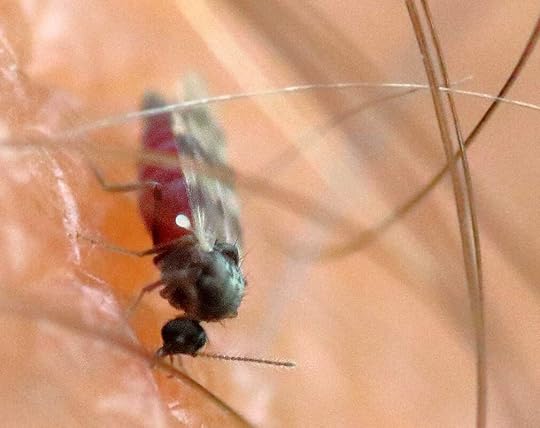
Photo Credits:
- Biting midge (no see um) - Dunpharlain, CC BY-SA 4.0, via Wikimedia Commons
This is one of those mysteries that seems like it should have a simple answer. It doesn’t. As it turns out, research shows that 10% to 20% of people are more appealing to biting insects than the rest of the population, but the reasons are far from simple. Insects are drawn to people using a vast array of senses, and they are drawn to a vast array of chemicals. Insects sense almost 300 different chemicals released in human odors. Each of these chemicals has different significance to different species of insects, and these chemicals occur in different mixtures and proportions, which change the way insects respond. There are thousands of different species of biting insects. Are you starting to see the complexity here?
Research has shown that about 85% of insect attraction is based on genetic traits that result in certain combinations of odors being emitted. As proof, biting insects show absolutely no preference when confronted with identical twins, but they show a clear preference when it comes to fraternal twins.
Where does that leave me? Welted and scratching. I guess I simply need to accept the facts as they are and keep spraying myself with Repel. Perhaps one day I will get my revenge on the no-see-ums of the world.
Below is a no-see-um, also known as a biting midge.

Photo Credits:
- Biting midge (no see um) - Dunpharlain, CC BY-SA 4.0, via Wikimedia Commons
Published on September 05, 2023 11:54
August 24, 2023
Awesome Animal Fact - World's Biggest Spider?
Did you know two different spider species tie for the honor of being the world's largest spider? They are the Goliath birdeater and the giant huntsman spider.
Why do I say these two spiders tie for first place? Let's look at the details. The Goliath birdeater, found in South America, can have a leg span of 12 inches (30 cm), and so can the giant huntsman.
But... the giant huntsman, found in Laos, reaches this size more often. Therefore, on average, the giant huntsman is bigger. The giant huntsman is the clear winner, right? Not really. You have to also consider weight. The giant huntsman weighs up to 167 grams, but the Goliath birdeater weighs up to 175 grams.
So, I proclaim (unofficially) that both of these spiders are the winners. Because... well, I do not want any spider that is a foot long to be upset with me.
Let's consider each species.
The Goliath birdeater (first photo below) is a type of tarantula. Does this spider really eat birds? They can, but they rarely do because birds are more difficult to catch than other prey. The name birdeater originated in the 1700s, from a copper engraving done by a German naturalist and illustrator who depicted one of these spiders feasting on a hummingbird. In reality, hummingbirds are really fast and hard to catch. But Goliath birdeaters are certainly big enough to eat small birds, rodents, frogs, lizards, and invertebrates.
The giant huntsman spider is in the huntsman family instead of the tarantula family, with a relatively smaller body size but longer legs. The giant huntsman wasn't discovered until 2001, when a German naturalist found one in a cave in Laos (I guess there are a lot of German spider experts...?). These huge spiders can move really fast, about one meter per second. This helps them run down their prey, which they kill by envenomation. See the second photo below.
There you have it... two world champion spiders.
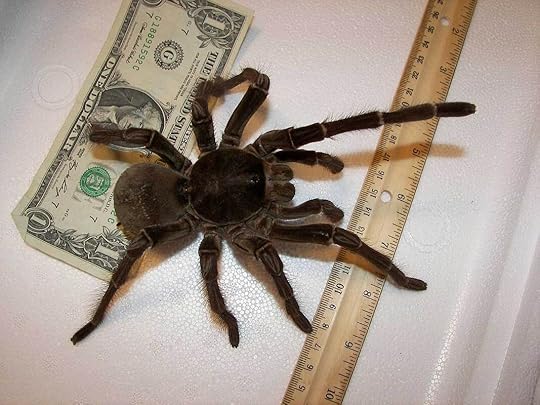
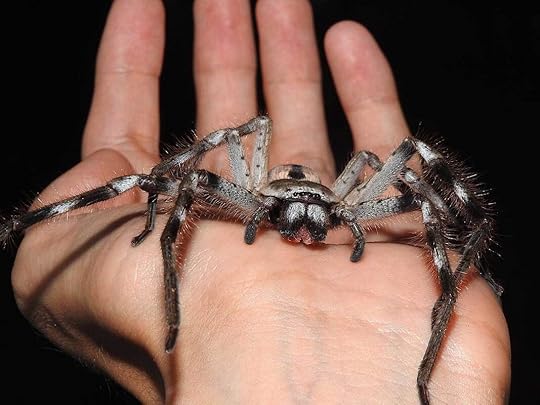
Photo Credits:
- Goliath birdeater - Snakecollector, CC BY 2.0, via Wikimedia Commons
- Giant huntsman spider - Jackson Nugent, CC BY 2.0, via Wikimedia Commons
Why do I say these two spiders tie for first place? Let's look at the details. The Goliath birdeater, found in South America, can have a leg span of 12 inches (30 cm), and so can the giant huntsman.
But... the giant huntsman, found in Laos, reaches this size more often. Therefore, on average, the giant huntsman is bigger. The giant huntsman is the clear winner, right? Not really. You have to also consider weight. The giant huntsman weighs up to 167 grams, but the Goliath birdeater weighs up to 175 grams.
So, I proclaim (unofficially) that both of these spiders are the winners. Because... well, I do not want any spider that is a foot long to be upset with me.
Let's consider each species.
The Goliath birdeater (first photo below) is a type of tarantula. Does this spider really eat birds? They can, but they rarely do because birds are more difficult to catch than other prey. The name birdeater originated in the 1700s, from a copper engraving done by a German naturalist and illustrator who depicted one of these spiders feasting on a hummingbird. In reality, hummingbirds are really fast and hard to catch. But Goliath birdeaters are certainly big enough to eat small birds, rodents, frogs, lizards, and invertebrates.
The giant huntsman spider is in the huntsman family instead of the tarantula family, with a relatively smaller body size but longer legs. The giant huntsman wasn't discovered until 2001, when a German naturalist found one in a cave in Laos (I guess there are a lot of German spider experts...?). These huge spiders can move really fast, about one meter per second. This helps them run down their prey, which they kill by envenomation. See the second photo below.
There you have it... two world champion spiders.


Photo Credits:
- Goliath birdeater - Snakecollector, CC BY 2.0, via Wikimedia Commons
- Giant huntsman spider - Jackson Nugent, CC BY 2.0, via Wikimedia Commons
Published on August 24, 2023 09:57
August 22, 2023
Life's Great Mysteries - Why do we have to go to the bathroom during the night more often as we get older?
I’ve been going to the Boundary Waters Canoe Area Wilderness since 1986 (and going there with Trish since 1992). Part of the appeal is the hardships involved with a true wilderness experience: portaging your canoe and gear from one lake to the next, cooking meals with minimal equipment, trying to stay dry when the rains come, and keeping the insects from sucking all the blood from your body, to name a few. Dealing with these hardships properly results in an ego boost. They make me feel like I’m Jeremiah Johnson, or at least a version of Jeremiah Johnson who enjoys comfy air mattresses and high-tech footwear.
There is, however, one hardship in the Boundary Waters I do not appreciate, and that hardship is becoming more bothersome as I get older. I’m talking, of course, about the need to crawl out of the tent in the middle of the night to urinate. There, I said it. To pee, to wizz, to take a leak, to micturate. It’s just not fun. There’s all that moaning and groaning to unzip the sleeping bag, trying to put on a pair of wet shoes, unzipping the tent and then zipping it back up to keep the mosquitoes out of the tent, stumbling over rocks and tent cords to move far enough away from the tent, finding a spot where the ground slopes away from your feet so the urine does not flow back onto your shoes (or bare feet), getting the job done while slapping mosquitoes, stumbling back to the tent, unzipping then rezipping the tent door, crawling back into the sleeping bag, turning on a flashlight and methodically killing the mosquitoes that got in during the process, then trying to go back to sleep.
There was a time when I could go all night without doing that. Those days are long gone. Now I have to go through it at least two times per night, sometimes more. The Great Mystery is, why?
My first thought was, this happens to those of us who were troublemakers in our younger days. But I know people who I’m quite sure are 'practically perfect in every way' who still have to pee at night as much as I do. As it turns out, it is not unusual at all. As we age, our bodies produce less of a hormone that helps concentrate urine so that we can hold it until the morning. Also, as we get older, we are likely to have other health issues that make it harder to hold it until morning, such as an enlarged prostate gland (in men) and lowered estrogen (in women), which causes changes in the urinary tract. There are plenty of other things that can cause it too. Bummer. Unfair. But, Trish and I are still going to the Boundary Waters.
There is, however, one hardship in the Boundary Waters I do not appreciate, and that hardship is becoming more bothersome as I get older. I’m talking, of course, about the need to crawl out of the tent in the middle of the night to urinate. There, I said it. To pee, to wizz, to take a leak, to micturate. It’s just not fun. There’s all that moaning and groaning to unzip the sleeping bag, trying to put on a pair of wet shoes, unzipping the tent and then zipping it back up to keep the mosquitoes out of the tent, stumbling over rocks and tent cords to move far enough away from the tent, finding a spot where the ground slopes away from your feet so the urine does not flow back onto your shoes (or bare feet), getting the job done while slapping mosquitoes, stumbling back to the tent, unzipping then rezipping the tent door, crawling back into the sleeping bag, turning on a flashlight and methodically killing the mosquitoes that got in during the process, then trying to go back to sleep.
There was a time when I could go all night without doing that. Those days are long gone. Now I have to go through it at least two times per night, sometimes more. The Great Mystery is, why?
My first thought was, this happens to those of us who were troublemakers in our younger days. But I know people who I’m quite sure are 'practically perfect in every way' who still have to pee at night as much as I do. As it turns out, it is not unusual at all. As we age, our bodies produce less of a hormone that helps concentrate urine so that we can hold it until the morning. Also, as we get older, we are likely to have other health issues that make it harder to hold it until morning, such as an enlarged prostate gland (in men) and lowered estrogen (in women), which causes changes in the urinary tract. There are plenty of other things that can cause it too. Bummer. Unfair. But, Trish and I are still going to the Boundary Waters.

Published on August 22, 2023 13:29
August 18, 2023
Awesome Animal Fact - Hot and Fast Ants
Did you know the Saharan silver ant is one of the fastest animals on Earth? It also has some of the most fascinating adaptations to extreme heat. As it turns out, these two capabilities are intricately connected.
As the name suggests, the Saharan silver ant lives in the Sahara Desert of northern Africa. The Sahara Desert is hot. How hot? As the hottest desert in the world, the Sahara can get up to 136º F (58º C). Typical daytime temperatures are around 117º F (47º C). As you can imagine, the sand gets even hotter.
So, it makes sense that silver ants would spend as little time out in the daytime heat as possible and as little time touching the hot sand as possible. They could just leave their burrows at night or in the cool morning to gather food, like many other desert animals do. But that's when countless ant-eating lizards are on the prowl. So, silver ants wait until it's so hot that even the ant-eating lizards can't stand it, and the lizards retreat below ground. BUT... when the temperature reaches the lethal level for the lizards, there is only about ten more minutes before it reaches the lethal level for the ants.
Therefore, the ants only have about ten minutes each day to leave their burrows to scavenge for insects and other animals that have died from the heat. TEN MINUTES per day!
This leads us to why the ants are so fast. They need to really boogie to find dead animals and drag them back into their burrows within ten minutes. So, they lift their front pair of legs off the ground and run at blistering speeds on only four legs. Quadrupedal ants... that's weird. But it reduces the ants' contact with the hot sand.
How fast can they run? Up to 108 times their own body length per second. Using this standard, only two other animals are faster, the Australian tiger beetle (171 body lengths per second) and the California coastal mite (377 body lengths). What about the cheetah? Sorry, cheetahs can only run 16 body lengths per second. Consider this: If I could run as fast as a silver ant (108 lengths of my body per second), my sprinting speed would be 368 miles per hour (592 km/hr).
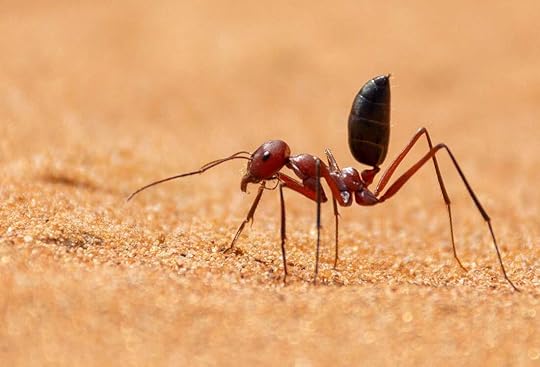
Photo Credits:
- Saharan silver ant - DepositPhotos
As the name suggests, the Saharan silver ant lives in the Sahara Desert of northern Africa. The Sahara Desert is hot. How hot? As the hottest desert in the world, the Sahara can get up to 136º F (58º C). Typical daytime temperatures are around 117º F (47º C). As you can imagine, the sand gets even hotter.
So, it makes sense that silver ants would spend as little time out in the daytime heat as possible and as little time touching the hot sand as possible. They could just leave their burrows at night or in the cool morning to gather food, like many other desert animals do. But that's when countless ant-eating lizards are on the prowl. So, silver ants wait until it's so hot that even the ant-eating lizards can't stand it, and the lizards retreat below ground. BUT... when the temperature reaches the lethal level for the lizards, there is only about ten more minutes before it reaches the lethal level for the ants.
Therefore, the ants only have about ten minutes each day to leave their burrows to scavenge for insects and other animals that have died from the heat. TEN MINUTES per day!
This leads us to why the ants are so fast. They need to really boogie to find dead animals and drag them back into their burrows within ten minutes. So, they lift their front pair of legs off the ground and run at blistering speeds on only four legs. Quadrupedal ants... that's weird. But it reduces the ants' contact with the hot sand.
How fast can they run? Up to 108 times their own body length per second. Using this standard, only two other animals are faster, the Australian tiger beetle (171 body lengths per second) and the California coastal mite (377 body lengths). What about the cheetah? Sorry, cheetahs can only run 16 body lengths per second. Consider this: If I could run as fast as a silver ant (108 lengths of my body per second), my sprinting speed would be 368 miles per hour (592 km/hr).

Photo Credits:
- Saharan silver ant - DepositPhotos
Published on August 18, 2023 09:11
August 10, 2023
Life's Great Mysteries - Why do hugs and handholding feel so comforting?
We all seem to know this, starting at birth. We like to be held and touched by those we care about. Dogs know this. Cats might know this. It doesn’t even have to be with your own species. People like cuddling with dogs and cats. Sometimes, cats and dogs even cuddle with each other—what is the world coming to?! Holding hands is good. Snuggling in bed is good, even when we are asleep and unaware we are snuggling… it’s still good. Playing footsie is good. And hugs are good, unless you’re a politician, then people of the opposing party will label you as creepy.
I seem to be addicted to hugs and handholding with Trish. It is almost as if I need a certain number of hugs each day to keep me in balance. We hold hands when we are traveling in the car or watching a movie. And lots of other people are like us. Think of all the little cooties and bacteria gleefully leaping from one person to the next. Yet, most people still crave such contact. Weird.
As it turns out, there is more to this than our desire to diversify our own cootie communities. The most obvious effect of hugs is due to this type of touch being a form of communication. Someone you care about is intentionally signaling to you that they care about you. That’s good. There is plenty of research showing that being touched in a loving and caring way not only decreases stress but also helps the recipient heal, recover, and grow. It’s a psychological thing. There is also a biological aspect—hugs release oxytocin, which is often called the cuddle hormone. It's released when we cuddle or bond, and it helps us relax.
There you have it. Hug your loved ones. Hug strangers if you so desire. The world needs more hugs.
I seem to be addicted to hugs and handholding with Trish. It is almost as if I need a certain number of hugs each day to keep me in balance. We hold hands when we are traveling in the car or watching a movie. And lots of other people are like us. Think of all the little cooties and bacteria gleefully leaping from one person to the next. Yet, most people still crave such contact. Weird.
As it turns out, there is more to this than our desire to diversify our own cootie communities. The most obvious effect of hugs is due to this type of touch being a form of communication. Someone you care about is intentionally signaling to you that they care about you. That’s good. There is plenty of research showing that being touched in a loving and caring way not only decreases stress but also helps the recipient heal, recover, and grow. It’s a psychological thing. There is also a biological aspect—hugs release oxytocin, which is often called the cuddle hormone. It's released when we cuddle or bond, and it helps us relax.
There you have it. Hug your loved ones. Hug strangers if you so desire. The world needs more hugs.

Published on August 10, 2023 12:30
August 5, 2023
Awesome Animal Fact - Kicking Kiwis
Did you know the kiwi (the bird, not the fruit) has really strong, muscular legs that make up a third of the bird's weight?
Kiwis are chicken-sized flightless birds that live only in New Zealand. Kiwis are ratites, along with emus, ostriches, cassowaries, and rheas. There are five living kiwi species.
Of course, without functional wings for flight, kiwis rely on their legs for moving around and escaping danger, but they also use their legs to kick logs apart to find the bugs inside, which they like to eat. They can deliver a wicked kick and run off possums that are trying to attack and eat their chicks. Male kiwis are territorial, and they often get into fierce fights with other male intruders, sometimes even resulting in injury or death. They even use their powerful legs and claws to dig the burrows in which they live.
Although a kiwi looks rather like a fat, furry pear, it can outrun a human.
In addition to tearing apart logs, kiwis hunt for bugs and worms by walking quietly through the forest at night (they are nocturnal) and tapping the ground with their sensitive beak. They are the only birds that have nostrils at the very end of their beak. When they detect a bug or worm under the surface, they jab their beak into the soil and pluck it out.

Kiwis are chicken-sized flightless birds that live only in New Zealand. Kiwis are ratites, along with emus, ostriches, cassowaries, and rheas. There are five living kiwi species.
Of course, without functional wings for flight, kiwis rely on their legs for moving around and escaping danger, but they also use their legs to kick logs apart to find the bugs inside, which they like to eat. They can deliver a wicked kick and run off possums that are trying to attack and eat their chicks. Male kiwis are territorial, and they often get into fierce fights with other male intruders, sometimes even resulting in injury or death. They even use their powerful legs and claws to dig the burrows in which they live.
Although a kiwi looks rather like a fat, furry pear, it can outrun a human.
In addition to tearing apart logs, kiwis hunt for bugs and worms by walking quietly through the forest at night (they are nocturnal) and tapping the ground with their sensitive beak. They are the only birds that have nostrils at the very end of their beak. When they detect a bug or worm under the surface, they jab their beak into the soil and pluck it out.

Published on August 05, 2023 08:03
July 31, 2023
Life's Great Mysteries - Why do mosquitoes always buzz near my ears?
You know what I’m talking about. Mosquitoes don’t mess around with buzzing your toes, or your buttocks, because that would not be nearly as annoying. A female mosquito beats her wings at about 500 flaps per second. That’s a lot of hard work. She doesn’t want to waste all that hard work unless she can really annoy you and make you slap your own face in your attempts to make the buzzing go away.
Well, as it turns out, there is more to the story than sheer pugnaciousness. You see, female mosquitoes need to drink blood. One good way to find blood is to follow the scent of carbon dioxide. Warm-blooded creatures happen to breathe out a lot of carbon dioxide, and we all know that warm blood is the tastiest blood, right? So, female mosquitoes zero in on the scent of CO2. That brings them close to our heads (because we don’t breathe carbon dioxide out our butts… that’s mainly hydrogen, methane, and hydrogen sulfide… the stuff that makes our farts smelly).
Once the female mosquito is in the vicinity of your face, she then begins to smell something else that gets her tiny little heart pounding with excitement—the odor of ear wax. Ear wax emits a smell that mosquitoes love.
Thus, I have finally solved the mystery, but this doesn’t really prevent me from slapping my own face to get rid of the annoying sound.
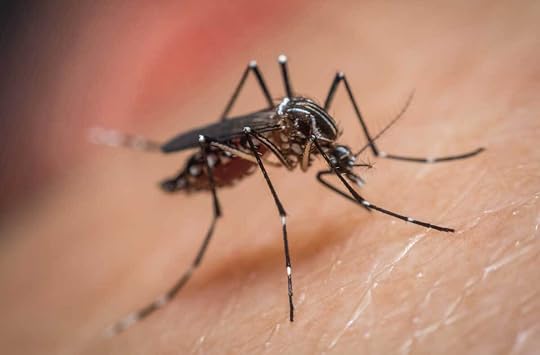
Photo Credits:
- Mosquito sucking blood - DepositPhotos
Well, as it turns out, there is more to the story than sheer pugnaciousness. You see, female mosquitoes need to drink blood. One good way to find blood is to follow the scent of carbon dioxide. Warm-blooded creatures happen to breathe out a lot of carbon dioxide, and we all know that warm blood is the tastiest blood, right? So, female mosquitoes zero in on the scent of CO2. That brings them close to our heads (because we don’t breathe carbon dioxide out our butts… that’s mainly hydrogen, methane, and hydrogen sulfide… the stuff that makes our farts smelly).
Once the female mosquito is in the vicinity of your face, she then begins to smell something else that gets her tiny little heart pounding with excitement—the odor of ear wax. Ear wax emits a smell that mosquitoes love.
Thus, I have finally solved the mystery, but this doesn’t really prevent me from slapping my own face to get rid of the annoying sound.

Photo Credits:
- Mosquito sucking blood - DepositPhotos
Published on July 31, 2023 09:46
July 27, 2023
Local Wildlife - Juvenile Barred Owl
We have a juvenile barred owl that is making itself at home in the vicinity of our deck. This youngster is still making the funny whistling call that juvenile barred owls make to contact their parents, probably when they want to be fed. This bird is obviously trying to learn to hunt. It sits in the trees next to our deck and stares at the birds and squirrels that come to our feeders. We haven't seen it try to catch one yet, but I hope to witness that soon (Trish told me to say only if it's one of those darn squirrels). I think it's trying to work up the nerve to dive at one of them.
If you aren't sure you have barred owls in your area, maybe you've heard their calls (which I love hearing). The adults have a distinctive baritone call that sounds like they are saying, "Who cooks, who cooks for youuuuuu?"
Below is a photo of our squirrel watcher. Notice it still has a bit of downy fuzz around the head.

If you aren't sure you have barred owls in your area, maybe you've heard their calls (which I love hearing). The adults have a distinctive baritone call that sounds like they are saying, "Who cooks, who cooks for youuuuuu?"
Below is a photo of our squirrel watcher. Notice it still has a bit of downy fuzz around the head.

Published on July 27, 2023 08:39
July 17, 2023
Life's Great Mysteries - Why does my hair turn gray as I get older?
Maybe a better question is… why does my younger brother’s hair NOT turn gray as he gets older?
My first thought was that this is the universe’s way of letting everybody know that I am no longer a salubrious young man. After all, people need to know not to ask me to help them carry a couch up to their third-floor apartment.
Another thought I had was that my life is full of stress. I’ve heard stress causes hair to turn gray. Maybe I’m kind of like Barack Obama—his hair turned gray during his presidency. But actually, my life is pretty cushy and undemanding, so that can't be it.
As it turns out, human hair does not really turn gray due to stress. And in reality, hair doesn’t turn gray at all. Once a hair follicle produces hair, the color is set, and it never changes. Well, unless you color your hair, of course.
However, as we get older, our hair follicles produce less color. So, as our hair goes through its natural cycle of dying (dying, as in dead, not dyeing as in coloring) and being replaced with new hairs, the new hairs are more likely to grow in gray, at least after we turn 35 or so.
So, why doesn’t my brother have gray hair like mine? Because we are two different people, with different genetics. Yes, we share 50% of our genes, but that leaves plenty of room for variation, and his genetic makeup happens to delay his new hairs growing in gray until much later. Unfortunately for him, people will be asking him to help carry couches up flights of stairs for many years to come.

Photo Credits:
- Gray hair - DepositPhotos
My first thought was that this is the universe’s way of letting everybody know that I am no longer a salubrious young man. After all, people need to know not to ask me to help them carry a couch up to their third-floor apartment.
Another thought I had was that my life is full of stress. I’ve heard stress causes hair to turn gray. Maybe I’m kind of like Barack Obama—his hair turned gray during his presidency. But actually, my life is pretty cushy and undemanding, so that can't be it.
As it turns out, human hair does not really turn gray due to stress. And in reality, hair doesn’t turn gray at all. Once a hair follicle produces hair, the color is set, and it never changes. Well, unless you color your hair, of course.
However, as we get older, our hair follicles produce less color. So, as our hair goes through its natural cycle of dying (dying, as in dead, not dyeing as in coloring) and being replaced with new hairs, the new hairs are more likely to grow in gray, at least after we turn 35 or so.
So, why doesn’t my brother have gray hair like mine? Because we are two different people, with different genetics. Yes, we share 50% of our genes, but that leaves plenty of room for variation, and his genetic makeup happens to delay his new hairs growing in gray until much later. Unfortunately for him, people will be asking him to help carry couches up flights of stairs for many years to come.

Photo Credits:
- Gray hair - DepositPhotos
Published on July 17, 2023 12:23
July 13, 2023
Awesome Animal Fact - Puffer-loving Dolphins
One more post in the category of animals that like to get high or drunk.
Did you know rough-toothed dolphins might enjoy getting intoxicated from pufferfish toxin? By the way, compared to the more common bottlenose dolphin, the rough-toothed dolphin has more white markings on its beak and sides.
This intoxication behavior was observed for the first time in 1995 by marine biologist Lisa Steiner. She was observing a group of about 60 dolphins. They appeared to be feeding, but they were acting strange. They didn't seem to have much energy. A few of them were feeding lazily, but most were just swimming around—slowly. Then Steiner saw four inflated pufferfish among the dolphins. In fact, the dolphins were pushing the pufferfish around with their beaks. Since then, this behavior has been observed by other biologists.
You may know that pufferfish produce a dangerous toxin. This toxin, called tetrodotoxin, is actually one of the deadliest compounds known to science. It is 120,000 times more deadly than cocaine, and is hundreds of times more deadly than the venom of a black mamba or a black widow spider. In small sublethal doses, such as what a dolphin might get from gently pushing an inflated pufferfish, the toxin induces numbness, similar to what was observed in the dolphins.
Now, I need to make it clear that some biologists do not believe the dolphins are doing this on purpose (or should I say, on porpoise? haha). Dolphins are curious animals, and they may like to play with or explore pufferfish. After all, an inflated pufferfish is a pretty strange sight to see. The dolphins may unintentionally dose themselves with the toxin during the process of investigating these weird, balloon-like fish.
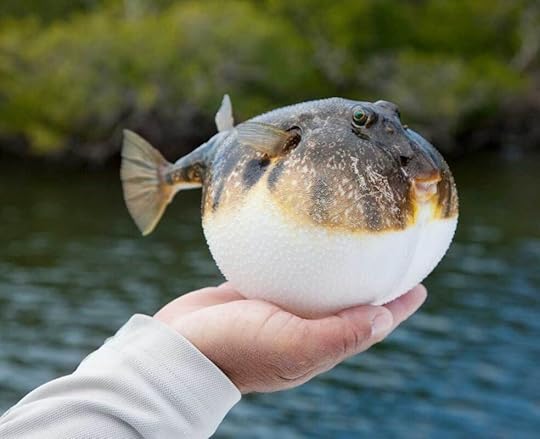
Inflated pufferfish - DepositPhotos
Did you know rough-toothed dolphins might enjoy getting intoxicated from pufferfish toxin? By the way, compared to the more common bottlenose dolphin, the rough-toothed dolphin has more white markings on its beak and sides.
This intoxication behavior was observed for the first time in 1995 by marine biologist Lisa Steiner. She was observing a group of about 60 dolphins. They appeared to be feeding, but they were acting strange. They didn't seem to have much energy. A few of them were feeding lazily, but most were just swimming around—slowly. Then Steiner saw four inflated pufferfish among the dolphins. In fact, the dolphins were pushing the pufferfish around with their beaks. Since then, this behavior has been observed by other biologists.
You may know that pufferfish produce a dangerous toxin. This toxin, called tetrodotoxin, is actually one of the deadliest compounds known to science. It is 120,000 times more deadly than cocaine, and is hundreds of times more deadly than the venom of a black mamba or a black widow spider. In small sublethal doses, such as what a dolphin might get from gently pushing an inflated pufferfish, the toxin induces numbness, similar to what was observed in the dolphins.
Now, I need to make it clear that some biologists do not believe the dolphins are doing this on purpose (or should I say, on porpoise? haha). Dolphins are curious animals, and they may like to play with or explore pufferfish. After all, an inflated pufferfish is a pretty strange sight to see. The dolphins may unintentionally dose themselves with the toxin during the process of investigating these weird, balloon-like fish.

Inflated pufferfish - DepositPhotos
Published on July 13, 2023 07:19



